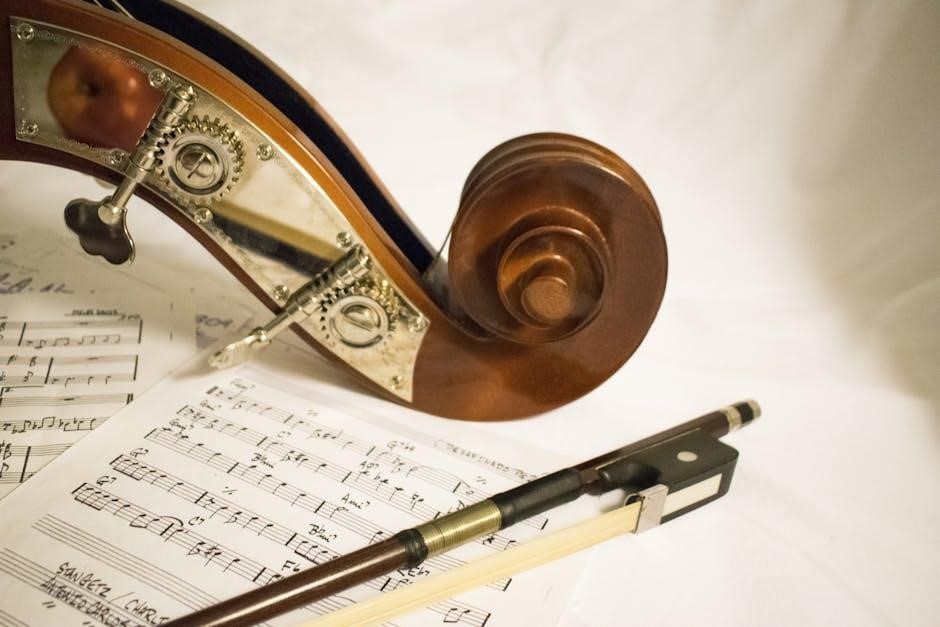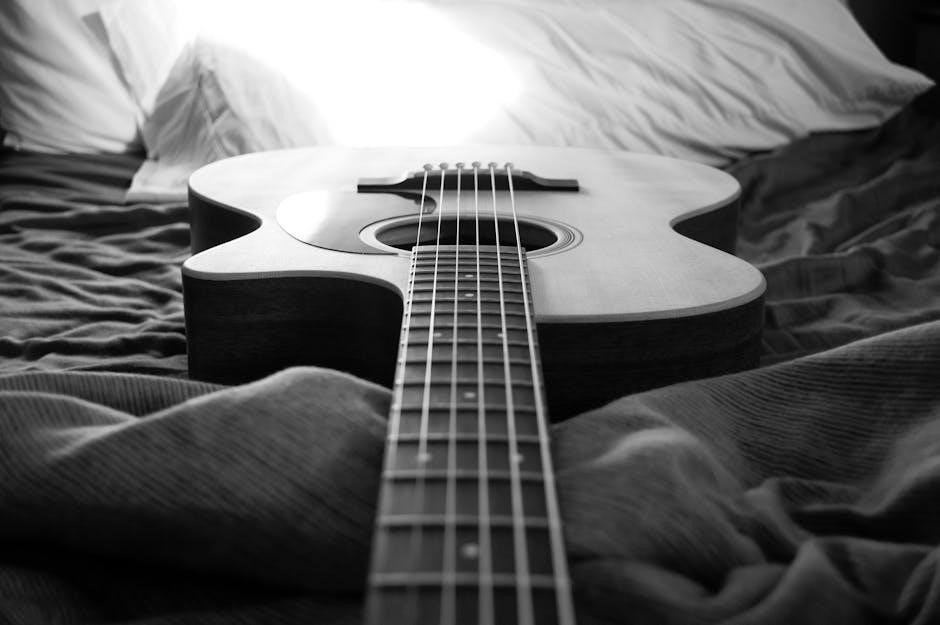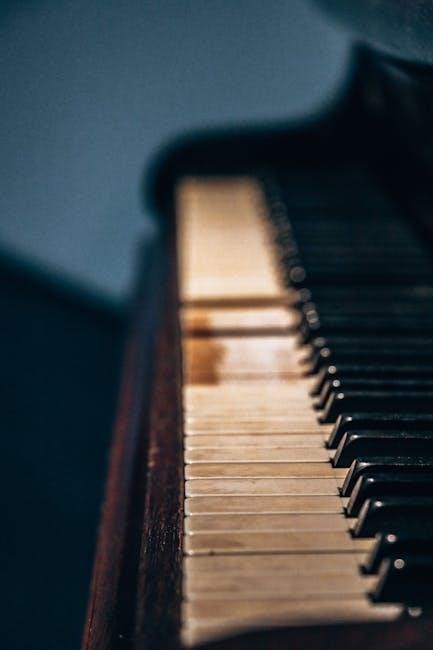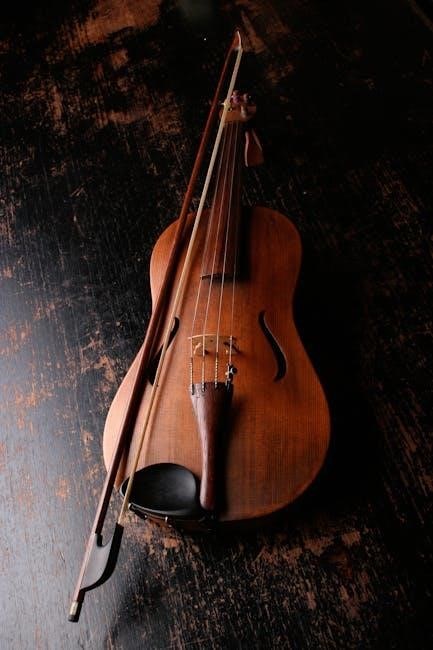
barber adagio for strings pdf
Samuel Barber’s Adagio for Strings is a renowned 20th-century classical composition, premiered in 1938. It is celebrated for its emotional depth and universal appeal, transcending traditional concert settings.
1.1 Overview of the Piece
Samuel Barber’s Adagio for Strings is a deeply moving composition, originally the slow movement of his String Quartet, Op. 11. Transcribed for string orchestra, it is characterized by its melancholic beauty, soaring melodies, and taut harmonies. The piece is marked by a mournful, cantabile style, evoking profound emotional resonance. Its simplicity and intensity have made it a timeless classic, widely performed and admired. The Adagio is often associated with moments of reflection and solemnity, reflecting its universal appeal and enduring impact on audiences worldwide.
1.2 Historical Significance
Samuel Barber’s Adagio for Strings holds profound historical significance, premiered in 1938 by the NBC Symphony Orchestra under Arturo Toscanini. It became a cultural touchstone, played at Albert Einstein’s funeral and featured in films like Oliver Stone’s Platoon. The piece symbolizes mourning and reflection, resonating deeply during times of loss. Its timeless appeal has cemented its place in classical music history, transcending traditional concert halls to become a universal expression of sorrow and remembrance, connecting generations through its emotional depth and simplicity.
1.3 Popular Use in Media and Culture
Barber’s Adagio for Strings has become a cultural phenomenon, featured in films, television shows, and commercials. Its haunting beauty is heard in movies like Platoon and The Elephant Man, amplifying emotional scenes. It has also been used in video games and memorials, such as the funeral of Albert Einstein. This piece transcends classical music, resonating with diverse audiences and solidifying its place in popular culture. Its universal emotional appeal continues to make it a favorite for directors and creators seeking profound expression.

Composition Details
Samuel Barber’s Adagio for Strings was composed in 1938 as the second movement of his String Quartet, Op. 11, later transcribed for string orchestra. It is dedicated to Louise and Sidney Homer, featuring a key signature of B-flat minor and a tempo marking of Molto adagio, espressivo cantando, pp.
2.1 Original Composition for String Quartet
Samuel Barber’s Adagio for Strings originated as the second movement of his String Quartet, Op. 11, composed in 1938. The piece was initially written for a traditional string quartet, featuring a melancholic and introspective melody. The original version is in the key of B-flat minor, marked Molto adagio, espressivo cantando, pp, reflecting its somber and expressive nature. This quartet version showcases Barber’s ability to craft emotionally charged music within a intimate ensemble setting, later transcribed for larger string orchestras while retaining its core emotional depth. The original composition remains a testament to Barber’s mastery of harmonic complexity and melodic simplicity, making it a cornerstone of 20th-century classical music. PDF versions of the original String Quartet arrangement are widely available for study and performance, offering musicians a direct connection to Barber’s initial creative vision.
2.2 Orchestration for String Orchestra
Barber’s Adagio for Strings was transcribed for a full string orchestra, expanding the original quartet version. The orchestration enhances the emotional depth by layering additional harmonies and textures. Scored for violins, violas, cellos, and double basses, it maintains the original’s expressive qualities while amplifying its impact. The arrangement retains the key of B-flat minor and tempo marking of Molto adagio, espressivo cantando, pp, creating a hauntingly beautiful sound. PDF versions of the orchestral score are widely available, allowing musicians to explore this iconic arrangement in detail.
2.3 Dedication to Louise and Sidney Homer
Samuel Barber dedicated the Adagio for Strings to his aunt and uncle, Louise and Sidney Homer, reflecting his deep personal connection to the piece. This dedication highlights the work’s emotional significance, as it was composed during a pivotal time in Barber’s life. The dedication is noted in the score, adding a layer of personal history to the composition. PDF versions of the sheet music often include this dedication, preserving the piece’s intimate origins for musicians and scholars alike;
2.4 Key Signature and Tempo Marking
Barber’s Adagio for Strings is written in the key of B minor, with a tempo marking of Molto adagio, indicating a slow and expressive pace. The piece begins with a somber, cantabile melody played by the violins, set against a backdrop of muted, sustained harmonies in the lower strings. This key and tempo combination creates a sense of profound sorrow and introspection, which has become a hallmark of the composition. These markings are faithfully preserved in PDF versions of the sheet music, ensuring accurate interpretation by musicians.

Historical Background
Barber’s Adagio for Strings premiered in 1938, conducted by Arturo Toscanini. It has been featured at notable events, including Einstein’s funeral, highlighting its enduring historical significance.
3.1 Premiere Performance in 1938
The Adagio for Strings had its premiere on November 5, 1938, performed by the NBC Symphony Orchestra under the baton of the renowned conductor Arturo Toscanini. This historic event marked the piece’s official introduction to the public, showcasing its profound emotional depth and elegance. Toscanini’s interpretation highlighted the work’s solemn beauty, setting the stage for its widespread acclaim. The premiere solidified Barber’s reputation as a leading composer of his time and remains a pivotal moment in the piece’s enduring legacy.
3.2 Conducted by Arturo Toscanini
Arturo Toscanini, a legendary conductor, played a pivotal role in the Adagio for Strings’ success. His expressive interpretation during the 1938 premiere brought out the piece’s emotional depth and elegance. Toscanini’s mastery in conveying the music’s solemn beauty resonated deeply with audiences, further cementing the work’s reputation. His conducting style, marked by precision and passion, elevated Barber’s composition to new heights, leaving an indelible mark on its performance history and legacy.
3.3 Notable Performances and Recordings
Leonard Bernstein’s interpretation with the Los Angeles Philharmonic is a landmark recording, capturing the piece’s haunting beauty. The St. Louis Symphony Orchestra, conducted by Leonard Slatkin, also delivered a memorable performance. These recordings highlight the Adagio’s emotional depth, showcasing its ability to evoke powerful feelings. The work has been widely performed and recorded, with each interpretation offering a unique perspective on its timeless elegance and somber grace, further solidifying its place in classical music history.
3.4 Use at Funerals and Memorial Services
Barber’s Adagio for Strings is often played at funerals and memorials due to its somber, reflective nature. It was notably performed at the funeral of Albert Einstein and during the procession for President Franklin D. Roosevelt. The piece’s solemn, heart-wrenching sadness provides solace and expresses deep mourning, making it a fitting choice for such solemn occasions. Its universal emotional appeal resonates with those grieving, offering a poignant soundtrack for remembrance and reflection.

Adagio for Strings in PDF Format
Samuel Barber’s Adagio for Strings is widely available in PDF format for download, offering musicians and enthusiasts access to its sheet music, score, and parts for study and performance.
4.1 Availability of Sheet Music
Sheet music for Samuel Barber’s Adagio for Strings is readily available in PDF format for download. Musicians can access the full score, parts, and arrangements online through various platforms. The composition, originally for string quartet, has been transcribed for string orchestra and other ensembles. Many websites offer free downloads, while others provide licensed versions for purchase. The sheet music is often accompanied by annotations and markings, such as those by Leonard Bernstein, ensuring authenticity and quality for performers. This accessibility has made the piece widely popular among musicians and educators worldwide.
4.2 Download Options for Musicians
Musicians can download Samuel Barber’s Adagio for Strings in PDF and MIDI formats from various online platforms. Free sheet music downloads are available, including transcriptions for string quartets and orchestras. Platforms offer arrangements by Neo Scott and others, ensuring versatility for different ensembles. Some sites provide licensed versions, while others offer free access, making it accessible to a wide range of performers. The PDF files often include detailed annotations, such as those by Leonard Bernstein, and are compatible with both personal and professional use.
4.3 Copyright and Licensing Information
Samuel Barber’s Adagio for Strings is copyrighted by G. Schirmer, Inc., with international rights secured. The original composition and its arrangements are protected under copyright law, requiring proper licensing for commercial use. While free downloads are available for personal use, musicians must obtain licenses for public performances or recordings. Specific arrangements, such as those marked by Bernstein, may have additional licensing requirements. It is essential to verify terms before use to ensure compliance with intellectual property regulations.

Structure and Musical Elements
Barber’s Adagio for Strings features a tense melodic line, taut harmonies, and a slow tempo, creating profound emotional depth. Its structure emphasizes expressive qualities and universal resonance.
5.1 Melodic Line and Harmonies
The Adagio for Strings is characterized by a simple yet deeply moving melodic line, supported by rich, intricate harmonies. The composition begins with a hauntingly beautiful theme in the violins, gradually unfolding into a tapestry of interweaving voices. Barber’s use of suspended chords and resolving harmonies creates a sense of tension and release, while the melodic line ascends and descends in a poignant, elegiac manner. This balance of simplicity and complexity gives the piece its enduring emotional resonance and universal appeal.
5.2 Dynamic Markings and Expressive Qualities
The Adagio for Strings features delicate dynamic markings that enhance its emotional intensity. The piece is marked Molto adagio (espressivo cantando) and begins with a pianissimo, creating a hushed, reflective atmosphere; As the music progresses, subtle dynamic contrasts emerge, with moments of swelling intensity followed by returns to softness. These expressive qualities, guided by Barber’s meticulous markings, allow performers to convey profound sadness and vulnerability without exaggerated dramatic flair, making the work deeply moving and universally relatable.

Instrumentation
Adagio for Strings is originally composed for a string quartet, later orchestrated for a full string orchestra, featuring violins, violas, cellos, and double basses, creating a rich texture.
6.1 String Quartet Version
The Adagio for Strings originated as the second movement of Barber’s String Quartet, Op. 11, transcribed for string orchestra. It features four parts: Violin I, Violin II, Viola, and Violoncello. The original quartet version showcases the intimate texture of chamber music, with a focus on melodic interplay and harmonic richness. The key signature is in B minor, marked Molto adagio, espr. cantando, pp, creating a somber yet expressive tone. This version remains a cornerstone of Barber’s oeuvre, reflecting his mastery of string writing.
6.2 Full String Orchestra Version
The Adagio for Strings was transcribed for full string orchestra, expanding the original quartet version. This arrangement, premiered by the NBC Orchestra under Arturo Toscanini in 1938, enhances the emotional depth with added layers of dynamics and texture. The orchestration maintains the hauntingly beautiful melody while amplifying the harmonic richness, creating a powerful and evocative sound that resonates deeply with audiences. This version remains the most widely performed and admired adaptation of Barber’s iconic work.

Emotional Impact and Reception
Barber’s Adagio for Strings evokes profound emotional depth, with its solemn, heart-wrenching sadness resonating universally. It has been featured at significant events, including Einstein’s funeral, amplifying its cultural impact.
7.1 Audience Response and Critical Acclaim
Barber’s Adagio for Strings has captivated audiences with its emotional depth and universality. Critics praise its hauntingly beautiful melodic lines and taut harmonies, which evoke profound sadness and reflection. The piece has been widely acclaimed for its ability to transcend traditional classical music settings, resonating with diverse audiences. Its use in films, such as Platoon, and at significant events, like Albert Einstein’s funeral, has further cemented its cultural significance. Many consider it one of the most moving works of the 20th century, with Leonard Bernstein’s interpretations being particularly noted for their expressive brilliance;
7.2 Emotional Depth and Universality
Barber’s Adagio for Strings is celebrated for its profound emotional depth, evoking a sense of solemn beauty and introspection. Its universal appeal lies in its ability to convey shared human experiences, transcending cultural and temporal boundaries. The composition’s hauntingly slow tempo and expressive melodies create a poignant atmosphere, often associated with moments of remembrance and reflection. This universal resonance has made it a staple in various contexts, from funerals to film scores, solidifying its place as a modern classical masterpiece.

Performance Guide
Musicians should approach Barber’s Adagio with sensitivity, emphasizing its slow tempo and expressive qualities to capture its emotional essence, as premiered by Toscanini in 1938.
8.1 Interpretation Tips for Musicians
When performing Barber’s Adagio, musicians should emphasize its emotional depth by maintaining a slow, deliberate tempo and expressive phrasing. Dynamics are crucial, with careful attention to crescendos and decrescendos to build tension and resolution. String players should focus on producing a rich, warm tone, particularly in the soaring melodic lines. Conductors should guide the ensemble to ensure cohesive pacing and balance, allowing the music’s inherent sadness and beauty to resonate. Following the premiere’s example, led by Toscanini, musicians can capture the piece’s haunting elegance and universal appeal.
8.2 Common Challenges in Performance
Performing Barber’s Adagio for Strings presents challenges, including maintaining the delicate balance between emotional intensity and restraint. Musicians must master the subtle shifts in dynamics and phrasing, as excessive expressiveness can overshadow the piece’s inherent elegance. Tempo control is critical, as the slow, mournful pace demands precise coordination among players. Additionally, the piece’s emotional depth requires performers to convey sincerity without over-sentimentalizing, ensuring a cohesive and impactful interpretation that honors Barber’s intent and resonates with audiences universally.

Arrangements and Transcriptions
Barber’s Adagio for Strings has been transcribed for various ensembles, including string quartet and full orchestra. Modern adaptations, like electronic versions, showcase its timeless appeal and versatility.
9.1 Arrangements for Different Ensembles
Barber’s Adagio for Strings, originally composed for string quartet, has been transcribed for various ensembles, including full string orchestra and other instrumental groups. The piece’s versatility allows it to maintain its emotional depth across different arrangements. Neo Scott’s transcription for string quartet and Leonard Bernstein’s orchestration are notable examples. These adaptations highlight the work’s universality and timeless appeal, making it accessible to a wide range of performers and audiences while preserving its original essence and expressive qualities.
9.2 Modern and Contemporary Adaptations
Barber’s Adagio for Strings has inspired modern and contemporary adaptations, showcasing its enduring relevance. Notable arrangements include electronic versions, such as William Orbit’s reinterpretation in “Pieces in a Modern Style,” blending classical and modern elements. The piece has also been featured in films like Platoon and The Elephant Man, underscoring its emotional resonance. Contemporary artists continue to explore its expressive potential, demonstrating its adaptability across genres and mediums. These adaptations highlight the work’s timeless appeal and its ability to connect with diverse audiences in new ways, ensuring its legacy endures.

Cultural Significance
Samuel Barber’s Adagio for Strings holds profound cultural significance, featured in films, memorials, and historical events, evoking universal emotion and becoming a cultural icon today.
10.1 Use in Film and Television
Samuel Barber’s Adagio for Strings is widely featured in film and television, enhancing emotional scenes with its solemn beauty. Its use in Oliver Stone’s Platoon and other movies underscores its power to evoke deep sentiment. The piece also appears in TV series and documentaries, illustrating its universal appeal. Its versatility and emotional depth make it a favorite among directors seeking to heighten dramatic impact. This timeless composition continues to resonate with audiences across various media platforms.
10.2 Association with Historical Events
Barber’s Adagio for Strings has been associated with significant historical events, becoming a symbol of collective mourning. It was played during the funeral of Albert Einstein in 1955 and at the funeral procession of President Franklin D; Roosevelt in 1945. Additionally, the piece was featured in the 1985 AIDS Memorial Quilt ceremony in Washington, D.C., further cementing its role in commemorating poignant moments in history. Its solemn beauty has made it a fitting choice for expressing grief and reflection during times of national and global significance;
Barber’s Adagio for Strings remains a timeless masterpiece, evoking profound emotion and connecting audiences across generations. Its legacy endures, with PDF sheet music widely available for musicians worldwide.
11.1 Legacy of the Adagio for Strings
Barber’s Adagio for Strings holds a profound legacy as one of the most cherished classical works of the 20th century. Its emotional resonance and timeless appeal have solidified its place in both concert halls and popular culture. The piece continues to inspire musicians and audiences alike, with its sheet music, including PDF versions, being widely accessed and performed by ensembles globally. Its enduring popularity is a testament to Barber’s mastery of evoking universal human emotion through music.
11.2 Continued Relevance in Modern Times
The Adagio for Strings remains highly relevant in modern times, with its emotional depth connecting across generations. Its widespread use in film, television, and memorials underscores its universal appeal. Musicians and educators continue to embrace the piece, with PDF sheet music readily available for study and performance. The work’s adaptability to various ensembles and contemporary arrangements further ensures its lasting impact, keeping Barber’s masterpiece at the forefront of classical and popular culture.